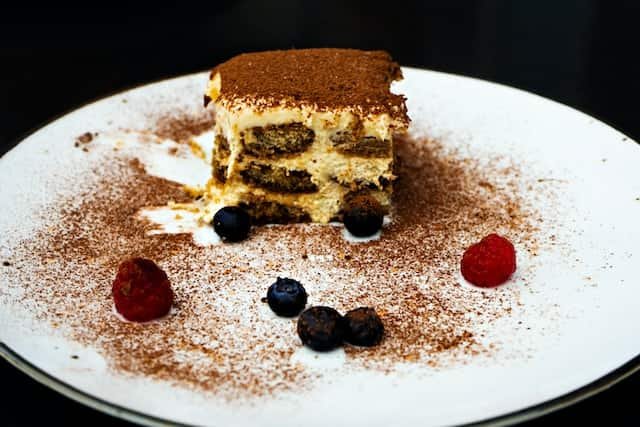The iconic Italian dessert tiramisu is adored by people all over the world. With several layers of ladyfingers, mascarpone dairy products, cocoa powder, and espresso, it is a sweet and creamy cake.
The presence of caffeine in this decadent dessert has many people wondering. Does tiramisu contain coffee?
The solution is more complex than one might initially believe. We must carefully examine the components and cooking techniques used to determine whether this adored treat contains any caffeine.
Factors Affecting the Caffeine Content of Tiramisu
Although the traditional tiramisu recipe asks for 1.5 shots of espresso, there are a number of variables that can affect the amount of caffeine. First and foremost, the espresso’s strength is crucial.
Tiramisu will have a somewhat greater caffeine content if the espresso is bolder and has more caffeine in it.
The quantity of the tiramisu might also influence the total amount of caffeine consumed. The amount of espresso in larger quantities may increase, boosting the amount of caffeine in each cup.
Finally, if you purchase or eat tiramisu, it’s likely that the recipe or technique of preparation differs, resulting in small changes in caffeine concentration.
How much caffeine does a tiramisu usually contain?
Tiramisu’s caffeine level can change based on the quantity and strength of the espresso used, among other things. Yet, a small-sized tiramisu normally includes about 75 mg of caffeine and is produced with about 1.5 shots of espresso.
What is known about the caffeine content in tiramisu
As we previously discussed, espresso, a coffee-based drink with a high caffeine content, is a component of tiramisu. Depending on the kind of coffee bean utilised and the length of time spent brewing, a single shot of espresso may contain between 64 and 100 milligrammes of caffeine.
While the quantity of espresso for Tiramisu might vary based on the recipe, it is generally accepted that each dish contains at least one shot. In other words, you can anticipate at least 64 mg of coffee in each dish of tiramisu.
What Does A Tiramisu Have In Caffeine?
Espresso is a traditional ingredient in tiramisu, however the quantity of caffeine varies. In fact, the coffee in some recipes for tiramisu is barely detectable. This dish typically includes 65 to 50 milligrammes of caffeine per serving.
You can exclude the espresso to create your own non-alcoholic Tiramisu if you’re concerned about the amount of caffeine in a traditional one. Tiramisu without alcohol is safe for children and expectant mothers. Additionally, it won’t keep you up all night.
For the identical coffee flavour, you can alternatively use decaffeinated coffee. A smart idea is to look at the ingredient list as well.
While many recipes for Tiramisu call for ordinary coffee, you can alternatively substitute for instant coffee granules or espresso powder.
How Should I Make Tiramisu? What Kind of Coffee Should I Use?
A traditional Italian espresso roast is the ideal coffee to use when creating tiramisu. The strong flavour and concentrated flavour of this espresso make it ideal for serving with tiramisu in cooler weather.
In addition, since espresso has the best flavour, many chefs advise using it in place of regular coffee while making tiramisu.
Although coffee liquor is an additional choice, instant espresso ought to be used if you want the most genuine flavour. Medium-dark or moderate roasts or aggressively brewed coffee can be used in a pinch, but for the best results, stay with the traditional Italian espresso roast.
Tiramisu’s caffeine content compared to a cup of coffee
When you devour a plate of tiramisu, a variety of factors impact how much coffee you actually consume. One thing is for sure: the size of the chunk you consume matters.
Another consideration is whether the dish was prepared with strong espresso or decaf coffee.
Around 95 milligrammes of caffeine are present in a typical cup of black coffee. A typical dish of tiramisu cooked with coffee that is strong has around 2/3 of that, or about the same as one shot of espresso.
To provide some more context, a cup in black tea has roughly 47 milligrammes of caffeine.
What Kind Of Coffee Is Best For Tiramisu?
Considering that coffee is a vital component of tiramisu, picking the appropriate kind of coffee is crucial.
Layers of silky smooth mascarpone, thick cream, or egg whites are placed between layers of ladyfingers that have been dipped in coffee. Your coffee must be the perfect strength to counteract the richness in this creamy concoction.
What are the Caffeine-Free Tiramisu Alternatives?
If you’re looking for alternative to Tiramisu with caffeine, there are several choices. You can try a kid-friendly, alcohol- and coffee-free variation of traditional Tiramisu, that’s ideal for people who are allergic to either.
Reduce the quantity of espresso utilised to dip the ladyfingers to create a low-caffeine variant of the traditional Italian delicacy.
You may also use tea, cocoa powder, and even fruit juices in place of coffee, or you could use a decaffeinated espresso. Whatever your inclination, you can find a tonne of recipes online to make a great tiramisu without any coffee.
Conclusion
Tiramisu needs coffee, which is an essential component. Use moderate to dark roast coffee beans to create a powerful brew for your Tiramisu in order to make it truly wonderful and unforgettable.
By doing this, you can make sure that the rich coffee flavour balances out the creamy texture of the mascarpone and cream combination without taking away from the delightful, distinct coffee flavour.


